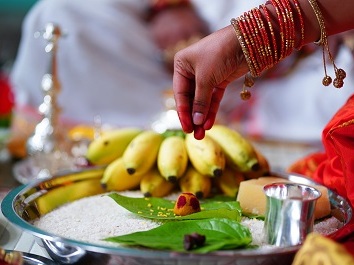Vedic puja is a form of worship in Hinduism that involves offering prayers and making offerings to the gods and goddesses. It is an important aspect of Hindu religious practice and is performed in temples, homes, and other sacred spaces.
There are several elements that are typically included in a vedic puja. These include:
-
The altar: The altar is a central feature of the puja and is usually adorned with flowers, incense, and other offerings. It may also include a sacred fire or lamp, as well as statues or images of the deities being worshipped.
-
The puja ritual: The puja ritual involves making offerings to the gods and goddesses, such as food, flowers, and other items. This may be done through the use of a puja thali, which is a tray or plate that holds the offerings. The offerings are placed on the altar and are accompanied by prayers and recitation of mantras.
-
The puja ceremony: The puja ceremony may include a variety of rituals and activities, depending on the specific deity being worshipped and the occasion. These may include chanting, singing, dancing, and other activities.
-
The puja aarti: The puja aarti is a ritual in which a lamp or other light is waved in front of the deity as a symbol of devotion and offering. This may be accompanied by singing and chanting.
-
The puja prasad: The puja prasad is the food or other offerings that are given to the gods and goddesses as part of the puja ritual. After the puja ceremony is completed, the prasad is usually distributed to those who participated in the puja, as well as to others who may be present.
-
The puja mantra: Mantras are sacred phrases or sounds that are believed to have spiritual power. They are often recited as part of the puja ritual as a way to connect with the divine and seek blessings. The mantras used in vedic puja may vary depending on the deity being worshipped and the specific purpose of the puja.
-
The puja yantra: A yantra is a geometric diagram that is used as a meditation and visualization tool in Hinduism. It is believed to represent the deity and to contain the deity's spiritual energy. Yantras are often used in vedic puja as a way to focus the mind and to establish a connection with the divine.
-
The puja pujan: Pujan is the act of offering worship or reverence to a deity. It is an important part of vedic puja and involves making offerings, reciting mantras, and performing other rituals to honor the deity.
-
The puja pradakshina: Pradakshina is the act of circumambulating (walking around) an object or place of worship. It is often done as part of vedic puja as a way to show respect and devotion to the deity. Pradakshina may be performed around the altar or around the deity's image or statue.
-
The puja havan: Havan is the ritual of offering oblations (offerings) to the sacred fire. It is an important part of vedic puja and is believed to purify the mind and body, as well as to bring blessings from the gods and goddesses. The havan may include the recitation of mantras and the offering of various items, such as ghee (clarified butter), grains, and flowers, into the fire.
Overall, vedic puja is a multifaceted ritual that involves a variety of elements and practices. It is an important part of Hindu religious life and is a way for believers to connect with the divine and seek blessings.


